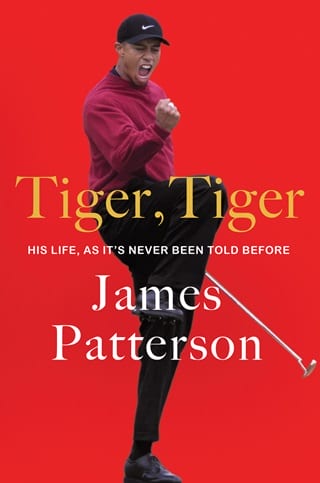Chapter 43
The 129th British Open
The Old Course, St Andrews Links
St Andrews, Scotland
July 20–23, 2000
The 129th playing of the British Open in a millennial year has been dubbed the Millennial Open at St Andrews. Adding to the inescapable variables of wind and rain, the 112 bunkers have been newly lined with sod. Players will have to dig deep to splash out from the steep, sandy traps.
Among the field will be Jack Nicklaus, who after missing the cut at his final U.S. Open continues his farewell-to-the-PGA tour with his British Open swan song. Nicklaus calls out the press for overhyping Tiger. It hasn’t helped that the captain and former secretary of the Royal and Ancient Golf Club of St Andrews walked the final round at Pebble Beach with Tiger and declared, “If Tiger doesn’t win at St. Andrews, there should be a stewards’ inquiry.”
“He has to have challengers for the whole thing to be right,” Nicklaus says. “It’s a bad story if there aren’t any challengers. You guys won’t have anything to write about.”
Three-time British Open champion (1987, 1990, 1992) and three-time Masters winner (1989, 1990, 1996) Nick Faldo is up for the test, having given his game and his equipment a complete overhaul. “Maybe it will happen again one more time,” says Faldo, who for ten years has held the scoring record on the Old Course: an 18-under 270.
Faldo knows his American competitor is increasingly strong, having built out his six-foot-one frame to a muscular 180 pounds. “Biceps almost like Schwarzenegger’s,” Faldo says. “I’m really making an effort to get stronger,” Jesper Parnevik tells Sports Illustrated. “It’s all Tiger’s fault.”
Tiger’s answer to Golf Digest’s request for a shirtless photo shoot? No.
But he’s hoping Mark O’Meara will say yes to more fly-fishing lessons. “I try to base my golf schedule around the fly-fishing season,” O’Meara says. “When the fishing is good that’s where you’ll find me, and when it’s not so good then I’ll play more tournaments.”
The pastime’s been sweeping the PGA. It was O’Meara who got Davis Love III hooked. “There’s never a locker room on tour that doesn’t have a fly rod in it,” Love says. “Some of the guys will bring rods around with them on their practice rounds to make a few casts.”
That the outdoor physical pursuit approximates the rhythms of golf and its demands for precision is a huge part of its appeal. “Fly-fishing is like golf in that you don’t get a second chance,” Faldo says. “Cast, line, position, drag. One thing wrong, and ‘bogey!’—you lose the fish.”
Since the early 1990s, O’Meara has traveled to Limerick, Ireland, to play the JP McManus Pro-Am and in 1997 he added an annual fishing trip on the River Liffey. This July, he invites Tiger along to the Limerick Golf Club. Tiger takes the tournament, donating his winnings—£33,000—to McManus’s charity, benefiting the children of southwest Ireland.
Tiger and O’Meara travel by helicopter to a luxury golf property outside Dublin called the K Club. O’Meara is the first out on the Liffey and, to Tiger’s envy, catches a nine-and-a-half-pound Atlantic salmon. The estate manager marvels at the ease of Tiger’s practice casts on land, though observing that “he won’t go near the water until he gets it right.”
Tiger and O’Meara’s friendship has always had an element of rivalry, which continues out on the K Club practice tee. The British Open at St Andrews is days away, and Tiger’s not hitting well. He turns to O’Meara and issues a challenge. “You need to start working on your game.”
“Bud, you have to work on your game,” O’Meara says. “Next week’s important to me, but obviously it’s a lot more important to you.”
“Why’s that?” Tiger says.
“Because my name’s already on that trophy,” O’Meara says. In 1998, he won both the Masters and the British Open.
“Yeah,” Tiger says, “but I’ve got more majors than you do. I’ve got you by one.”
“Bud,” O’Meara says, “you’re going to go so far past me and a lot of other players, it’s not even funny.”
Tiger gets serious about his pre-tournament practice sessions. His putting regimen: execute one hundred consecutive six-foot putts using only his right hand. The dedication shows in his first-round score of 5-under 67, anchored by a consistent putting game that delivers eight consecutive pars on the front nine and five birdies on the final ten holes. Ernie Els turns in a 66 for a one-stroke lead. The South African’s advantage is fleeting. Tiger executes a bogey-free round 2 that puts him three strokes ahead of American David Toms, who finished tenth on the 1999 tour money list, though he’s yet to win a major.
Tiger and Toms are paired together in the third round. Toms pulls within two strokes, only to fall four back.
On the par-five 14th, Tiger and Steve Williams confer over Tiger’s second shot. The club selection is a fairway wood with twelve degrees of loft. Tiger drives the ball 270 yards. As the Nike Tour Accuracy soars, Tiger says to Williams, “That the one you’re talking about?”
“All players have some preshot routine,” Nick Faldo explains. “Tiger has blitzed all that. There’s no twitch, no lift of the hat, no wasted energy.”
Except for the sneezing. Northeast Scotland is in the height of its summer bloom—and the irritants have Tiger making frequent use of handkerchiefs and eye drops. “I’m allergic to grass, trees, dust, pollen,” Tiger says. “It’s something I’ve always had. When I was a kid, it was ten times worse than it is now.”
The crowds have also become exponentially more intense. “I have never seen so many people on a golf course,” David Toms says. Attendance is approaching two hundred thousand with the final round still to be played.
On Sunday, the Old Course is buzzing with forty-seven thousand people waiting to see where Tiger takes his six-stroke lead. His playing partner, David Duval, makes four birdies on the front nine, cutting Tiger’s lead to three, only to falter with his putting. On 17, Duval takes on one of golf’s most notorious sand traps—the Road Hole bunker—losing four strokes and any hope of winning in the famous hell hole.
The Claret Jug belongs to Tiger, though he has yet to play 18. Before he can step to the tee, Her Majesty’s Officers of Arms lose control of security. The crowd bursts through the rope barriers onto the 18th fairway, pushing along the creek known as Swilken Burn and toward the tee. The course marshals toss rowdy spectators into the water but can’t reach the flag before a tattooed streaker dances around it in full view of the cameras.
Tiger plays through. “Somebody out there,” Denmark’s Thomas Bj?rn says, “is playing golf on a different planet.”
Or maybe he’s just used to it. The last time he was at Carnoustie, in 1999, a blond woman in a black thong bikini ran out to give Tiger a hug and a kiss on the cheek as he was preparing to make a putt on the 18th. “Thank you,” he said before missing the putt.
“I wasn’t worried,” he said afterward, joking that “I knew she wasn’t hiding anything. She didn’t have a whole lot on, so I guess I assumed it was a pretty benign situation.”
“It was the best kiss I ever had. It was worth it,” the woman, ID’d as exotic dancer Yvonne Robb, said. “I just love Tiger. I’ll have to surprise you all again next year.”
So far, there’s been no sign of her.
Bj?rn and South Africa’s Ernie Els have tied for second. As Tiger completes his career grand slam, Els’s runner-up finish at three of 2000’s majors have him in the running for the “mini slam,” or “bridesmaid slam.”
Without putting a single ball in a bunker, Tiger shoots 69 for the round and a 19-under 269 for the tournament—besting by one stroke Nick Faldo’s 1990 record for a British Open played at St Andrews.
Faldo, who finishes well back at 287, praises Tiger for breaking the conventions of this centuries-old sport. “The guy is simply in a different league,” Faldo says. “All credit to him. He’s thrown all these old myths out of the window, that you can’t physically train for golf, you can’t be strong or you are going to lose your touch.”
The significance of Tiger’s incredible achievement is not lost on anyone—not even his typically stoic mother. “When Tiger win at Masters first time, and the old man sobbing, I was very happy but not break down,” Tida says. When he won the U.S. Open, and “all the people on the fairway bowed to him, I think ‘That’s nice.’ But that’s all.” But now, when Tida sees him “coming up the last hole of the Old Course, which is so much history, and all the people are waving and applauding,” the magnitude of the moment hits her. “‘That is my son.’ I got a damp in my eye. It just come up.”
At Royal Air Force Leuchars, a nearby air base, an IMG-chartered jet with a flight plan for Orlando, Florida, is waiting on the tarmac. Its passengers are five minutes away at the Old Course Hotel in St Andrews. Two of them, Tiger’s good friend David Duval and Australian golfer Stuart Appleby, tied for eleventh today. Both golfers are asking the same question: “Is Tiger ready?”
The British Open champion emerges from the hotel carrying the Claret Jug and a carry-on bag stickered with one of Tiger’s favorite cartoon characters, South Park’s Eric Cartman.
“Bye, Mom, I love you,” Tiger says to Tida. “I’ll call you when I get back.”
 Fullepub
Fullepub 



